Your vehicle’s transmission fluid keeps the transmission system lubricated and pressurized. The fluid pressure is used hydraulically to apply clutches, brakes, and servos, and to move the valves in the valve body during transmission shifts. And again, the fluid also cools and lubricates.
To do its job properly, the transmission fluid needs to stay clean. Contaminated transmission fluid can cause your vehicle’s transmission to overheat and negatively affect shifting.
Manufacturers have been building automatic transmission vehicles with a transmission filter below the valve body so that the fluid is drawn through the filter and into the transmission fluid pump before filling the torque converter and pressurizing the rest of the transmission.
It’s enough to keep your vehicle’s transmission system running for some time, but there are also benefits to adding an inline transmission filter to the system. The inline filter is installed in one of the lines leading to the transmission cooler. It’s best to put the filter in the line where the fluid is flowing back to the transmission from the cooler in case there are particles already gathering in the cooler.
That being said, if there are particles in the transmission fluid, it typically means you have issues that installing a transmission inline filter won’t help. Particles come from components that are wearing out. Some of them are small enough to pass through the original filter you change when you do a transmission service. When they do, they tend to cause valve body problems that can manifest as harsh shifting issues or taking off in the wrong gear.
What Is an Inline Transmission Filter?
An inline transmission filter protects your vehicle’s transmission system by filtering contaminants like dirt and debris from your vehicle’s transmission fluid. Inline transmission filters attach along the transmission fluid line itself. As the fluid flows through the filter, the contaminants end up trapped in the filter’s fins. In addition, some filters contain magnets along their insides to attract ferrous contaminants, which the transmission system naturally generates over time. But again, you need to know which line leads back to the transmission from the transmission cooler and you should install the filter in that line.
Inline Transmission Filter Benefits and Drawbacks
Installing an inline transmission filter has its benefits and drawbacks, which you should consider before purchasing a kit.
Benefits
The main benefit of using an inline transmission filter is that it can extend your transmission system’s life and increase fuel efficiency. Keeping the particulates away from the rest of the system reduces damages.
Certain inline transmission filters can even reduce contamination levels in old transmission fluid, making it usable again. While this isn’t an excuse to skip replacing your vehicle’s transmission fluid, it shows how much of a difference these filters can make. They ultimately provide an extra level of protection to the transmission system lines, protecting them from blockages and helping them run more efficiently. Inline transmission filters also reduce transmission vibration and noise.
Drawbacks
Unfortunately, installing an inline transmission filter can be rather costly depending on the filter’s size and type. You might also need to do frequent maintenance work on the filter depending on the manufacturer’s instructions. Some mechanics also believe that adding an inline transmission filter is unnecessary and can impede transmission fluid flow and efficiency.
Things To Consider When Choosing an Inline Transmission Filter
When picking an inline transmission filter, there are a few considerations you need to note.
Affordability and Filter Type
There are different sizes and types of inline transmission filters on the market, and their prices can vary greatly. Figure out what kind of filter you need for your vehicle specifically and check if it’s within your budget. Inline transmission filters include the following types:
- Magnetic filters, which use magnetism to attract metal particles
- Depth filters, which trap debris using cellulose fibers
- Screen filters, which filter the transmission fluid through a metal or nylon mesh
- Centrifugal filters, which spin the transmission fluid in a rotor to separate contaminants
Maintenance
Remember that no matter what type of filter you purchase, you also need to account for its maintenance. Once you install a filter, you’ll need to change it out or clean it regularly to keep your vehicle’s transmission system working well. Some filters will only need periodic cleaning while other filters might require frequent transmission filter changes.
Installation Method
While installing an inline transmission filter on your own is entirely doable, make sure you’re familiar with the tools and system before you go cutting up any lines. This is a project best left to experienced DIYers and professionals. While it’s more expensive to have the filter professionally installed, it’s better to be safe than sorry if you aren’t entirely confident. If you fail to install the filter properly, it might cause transmission issues.
Now that you’re familiar with the benefits and drawbacks of inline transmission filters, you can decide for yourself whether you want to install one in your vehicle. It might not be necessary, but the added layer of protection won’t hurt.
Get High-Quality Automatic Transmission Filters Online
As your vehicle accumulates mileage, some transmission components like the automatic transmission filter will need to be replaced. This is typically done around 50,000 to 60,000 miles, depending on the vehicle. It’s best to stay on top of maintenance when it comes to the transmission filter or your transmission might have problems. Don’t hesitate to replace your vehicle’s automatic transmission filters so that the transmission can shift reliably.
Good thing CarParts.com is a trusted source when it comes to consumable parts like automatic transmission filters. We source our parts from reputable aftermarket manufacturers. Rest assured that our parts will function just like the original, as they’ve been made with the specifications of your vehicle in mind and have passed stringent testing and quality control standards.
When shopping for components, you’ll need to choose the model compatible with your vehicle model. Luckily, that’s as easy as pie since we have a vehicle selector that allows you to filter results to parts compatible with your vehicle model.
Check out our selection of high-quality automatic transmission filters here at CarParts.com today!
Any information provided on this Website is for informational purposes only and is not intended to replace consultation with a professional mechanic. The accuracy and timeliness of the information may change from the time of publication.







































